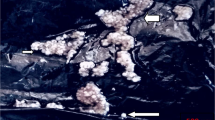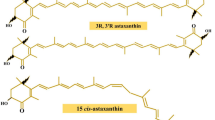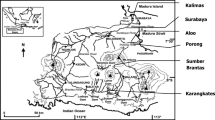Abstract
Effect of the low level of copper exposure on nonenzymatic antioxidants was studied in a freshwater fish Channa punctatus (Bloch.). Fish were exposed to cupric chloride at the concentration of 10 ppb for 4 wk (28 d) in a static culture condition. Copper significantly (p < 0.001) increased the serum ceruloplasmin level and total iron-binding capacity. A significant (p < 0.05) increase in reduced glutathione level was recorded in all of the tissues. With regard to nonprotein thiols, copper decreased their level in the liver, but increased it in the gill. The protein-bound thiols remained unaltered except for an increase in the liver. Metallothionein (MT) induction was observed in liver only. Copper exposure had no significant effect on the ascorbic acid level and induced no lipid peroxidation over control values. It is suggested that by modulating the ceruloplasmin level, copper indirectly protects the fish, as it facilitates conversion of pro-oxidant iron to nonoxidant iron. It also induces an array of antioxidants that may be beneficial to fish in the case of oxidative stress resulting from chemical pollutants.
Similar content being viewed by others
References
C. A. Villar, S. E. Gomez, and C. A. Bentos, Lethal concentration of Cu in the neotropical fish Cnesterodon decemmaculatus (Pisces, Cyprinodontiformes), Bull. Environ. Contam. Toxicol. 65, 465–469 (2000).
G. M. Christensen, J. M. McKim, W. A. Brungs, et al., Changes in the blood of the brown bullhead (Ictalurus nebulosus Lesueur) following short and long term exposure to copper(II), Toxicol. Appl. Pharmacol. 23, 417–427 (1972).
W. B. Horning and T. W. Nieheisel, Chronic effect of copper on the bluntnose minnow, Pimephales notatus (Rafinesque), Arch. Environ. Contam. Toxicol. 8, 545–552 (1979).
J. M. McKim, G. M. Christensen, and E. P. Hunt, Changes in the blood of brook trout (Salvelinus fontinalis) after short-term and long-term exposure to copper, J. Fish. Res. Bd. Can. 27, 1883–1889 (1970).
R. D. Handy, Dietary exposure to toxic metals in fish, in Toxicology of Aquatic Pollution: Physiological, Cellular and Molecular Approaches, E W. Taylor, ed., Cambridge University Press, Cambridge, pp. 29–60 (1996).
G. Roesijadi and W. E. Robinson, Metal regulation in aquatic animals: mechanisms of uptake, accumulation and release, in Aquatic Toxicology: Molecular, Biochemical and Cellular Perspectives, D. C. Malins and G. K. Ostrander, eds., Lewis, Boca Raton, FL, pp. 387–420 (1994).
M. M. Wintrobe, E. G. Cartwright, and J. G. Gubler, Studies on the function and metabolism of copper, J. Nutr. 50, 395–419 (1953).
J.M.C. Gutteridge, Superoxide dismutase (erythrocuprein) and free-radicals in clinical chemistry, Ann. Clin. Biochem. 13, 393–398 (1953).
C. A. Reilly, M. Sorlie, and S. D. Aust, Evidence for a protein-protein complex during iron loading into ferritin by ceruloplasmin, Arch. Biochem. Biophys. 254, 165–171 (1998).
L. L. Costanzo, G. D. Guidi, S. Giuffrida, et al., Determination of superoxide dismutase like activity of copper(II) complexes. Relevance of the speciation for the correct interpretation of in vitro O− 2 scavenger activity, J. Inorg. Biochem. 50, 273–281 (1993).
D. G. Dixon and J. B. Sprague, Acclimation to copper by rainbow trout Salmo gairdneri—a modifying factor in toxicity, Can. J. Fish Aquat. Sci. 38, 880–888 (1981).
D. Dupuy and S. Szabo, Protection by metals against ethanol-induced gastric mucosal injury in the rat, Gastroenterology 91, 966–974 (1986).
D. J., Lauren and D. G. McDonald, Acclimation to copper by rainbow trout, Salmo gairdneri physiology, Can. J. Fish Aquat. Sci. 44, 99–104 (1987).
I. Ahmad, T. Hamid, M. Fatima, et al., Induction of hepatic antioxidants in freshwater catfish (Channa punctatus Bloch.) is a biomarker of paper mill effluent exposure, Biochim. Biophys. Acta 1523, 37–48 (2000).
S. Pandey, I. Ahmad, S. Parvez, et al., Effect of endosulfan on antioxidants of freshwater fish Channa punctatus Bloch. 1. Protection against lipid peroxidation in liver by copper pre-exposure, Arch. Environ. Contam. Toxicol. 41, 345–352 (2001).
L. S. Clesceri, A. E. Greenberg, and A. D. Eaton, eds., American Public Health Association (APHA), Standard Methods for the Examination of Water and Wastewater, 20th ed., American Public Health Association, Washington, DC (1998).
H. K. Schosinsky, P. H. Lehmann, and F. Beeler, Measurement of ceruloplasmin from its oxidase activity in serum by use of o-dianisidine dihydrochloride, Clin. Chem. 20, 1556–1563 (1974).
W. N. Ramsay, The determination of the total iron-binding capacity of serum, Clin. Chim. Acta 259, 25–30 (1997).
J. Mohandas, J. J. Marshall, G. G. Duggins, et al., Differential distribution of glutathione and glutathione related enzymes in rabbit kidney. Possible implications in analgesic neuropathy, Cancer Res. 44, 5086–5091 (1984).
D. W. Jollow, J. R. Mitchell, N. Zampaglone, et al., Bromobenzene-induced liver necrosis: protective role of glutathione and evidence for 3,4-bromobenzeneoxide as the hepatotoxic intermediate, Pharmacology 11, 151–169 (1974).
J. Sedlak and H. R. Lindsay, Estimation of total, protein-bound and nonprotein sulfhydryl groups in tissues with Ellman’s reagent, Anal. Biochem. 25, 192–205 (1968).
I. Sayeed, I. Ahmad, M. Fatima, et al., Inhibition of brain Na+, K+-ATPase in freshwater fish (Channa punctatus Bloch) exposed to paper mill effluent, Bull. Environ. Contam. Toxicol. 65, 161–167 (2000).
S. Majhi, B. S. Jena, and B. K. Patnaik, Effect of age on lipid peroxides, lipofuscin and ascorbic acid contents of the lungs of male garden lizard, Comp. Biochem. Physiol. 126(C), 293–298 (2000).
U. K. Laemmli, Cleavage of structural proteins during the assembly of the head of bacteriophage T4, Nature 227, 680–685 (1970).
M. Uchiyama and M. Mihara, Determination of malonaldehyde precursor in tissues by thiobarbituric acid test, Anal. Biochem. 86, 271–278 (1978).
O. H. Lowry, N. J. Rosenbrough, A. L. Farr, et al., Protein measurement with Folin phenol reagent, J. Biol. Chem. 193, 265–275 (1951).
S. Osaki, D. A. Johnson, and E. Frieden, The mobilization of iron from the perfused mammalian liver by a serum copper enzyme, ferroxidase I, J. Biol. Chem. 246, 3108–3023 (1971).
Z. L. Harris, Y. Takahashi, H. Miyajima, et al., Aceruloplasminemia: molecular characterization of this disorder of iron metabolism, Proc. Natl. Acad. Sci. USA 92, 2539–2543 (1995).
J. R. Proshaka, Biochemical functions of copper in animals, in Essential and Toxic Trace Elements in Human Health and Disease, A. S. Prasad, ed., Alan R. Liss, New York, pp. 105 (1994).
P. L. Fox, B. Mazumdar, E. Ehrenwald, et al., Ceruloplasmin and cardiovascular disease, Free Radical Biol. Med 28, 1735–1744 (2000).
R. J. Cousins, Adsorption, transport and hepatic metabolism of copper and zinc: special reference to metallothioneins and ceruloplasmin, Physiol. Rev. 65, 238–311 (1985).
V. M. Samokyszyn, D. M. Miller, D. W. Reif, et al., Inhibition of superoxide and ferritin-dependent lipid peroxidation by ceruloplasmin, J. Biol. Chem. 264, 21–26 (1989).
J. M. Gutteridge, Inhibition of the Fenton reaction by the protein caeruloplasmin and other copper complexes. Assessment of ferrioxidase and radical scavenging activities, Chem. Biol. Interact. 56, 113–120 (1985).
J. A. McCarter and M. Roch, Hepatic metallothionein and resistance to copper in juvenile coho salmon, Comp. Biochem. Physiol. 74(C), 133–137 (1983).
M. Saito and I. Bremner, Oxygen free radicals and metallothionein, Free Radical Biol. Med. 14, 325–337 (1993).
J. T. Buckley, M. Roch, J. A. McCarter, et al., Chronic exposure of coho salmon to sublethal concentrations of copper—I. Effects on growth, accumulation and distribution of copper and on copper tolerance, Comp. Biochem. Physiol. 72, 15–19 (1982).
K. Julshamn, K. J. Andersen, O. Ringdal, et al., Effects of dietary copper and zinc in the rainbow trout, Salmo gairdneri, Aquaculture 73, 143–155 (1988).
N. S. Kosower and E. N. Kosower, The glutathione status of cells, Int. Rev. Cytol. 54, 109–159 (1978).
D. J. Reed and P. W. Beatty, Biosynthesis and regulation of glutathione: toxicological implications, in Reviews in Biochemical Toxicology, E. Hodgson, J. R. Bend, and R. M. Philpot, eds., Elsevier, Amsterdam, pp. 213–241 (1980).
L. Milne, P. Nicotera, S. Orrenius, et al., Effect of glutathione and chelating agents on copper mediated DNA oxidation: pro-oxidant and antioxidant properties of glutathione, Arch. Biochem. Biophys. 304, 102–109 (1993).
L. Vigano, A. Arilloi, C. Falugi, et al., Biomarkers of exposure and effect in flounder (Platichthys flesus) exposed to sediments of the Adriatic sea, Mar. Pollut. Bull. 42, 887–894 (2001).
Author information
Authors and Affiliations
Rights and permissions
About this article
Cite this article
Parvez, S., Sayeed, I., Pandey, S. et al. Modulatory effect of copper on nonenzymatic antioxidants in freshwater fish Channa punctatus (Bloch.). Biol Trace Elem Res 93, 237–248 (2003). https://doi.org/10.1385/BTER:93:1-3:237
Received:
Accepted:
Issue Date:
DOI: https://doi.org/10.1385/BTER:93:1-3:237




